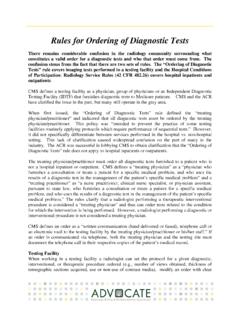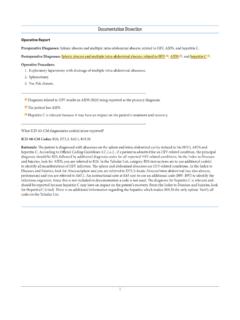Transcription of Coding for Angioplasty & Stent Procedures
1 Coding for Angioplasty & Stent ProceduresJuly 2020 Jennifer Bash, RHIA, CIRCC, RCCIR, CPC, RCCD irector of Coding EducationAgenda Introduction Definitions General Coding Guidelines Presenting Problems/Medical Necessity for Angioplasty & Stent General Angioplasty & Stent Procedures Cervicocerebral Procedures Lower Extremity ProceduresDisclaimerThe information presented is based on the experience and interpretation of the presenters. Though all of the information has been carefully researched and checked for accuracy and completeness, ADVOCATE does not accept any responsibility or liability with regard to errors, omissions, misuse or codes are trademark and copyright of the American Medical AMA CMS ACR/SIR ZHealth PublishingAngioplasty & Stent ProceduresAngioplastyAngioplasty, also known as balloon Angioplasty and percutaneous transluminal Angioplasty , is a minimally invasive endovascular procedure used to widen narrowed or obstructed arteries or veins, typically to treat arterial StentA Stent is a tiny tube placed into the artery or vein used to treat vessel narrowing or blockage.
2 Most stents are made of a metal or plastic mesh-like Angioplasty & Stent Coding Guidelines Angioplasty is not separately billable when done with a Stent Pre-Dilatation PTA converted to Stent Prophylaxis EXCEPTION-Complication extending to a different vessel Coded per vessel Codes include RS&I Territories HierarchyGeneral Angioplasty & Stent Coding Guidelines Bridging/Contiguous lesions Short lesion between 2 vessels=1 intervention Long lesion crossing entire length of 2 adjacent vessels with separate balloon or Stent = 2 interventions Two distinct lesions in adjacent vessels = 2 interventions Hemodynamically significant stenosis Angiography not separately billable Exception: No prior angiographic imaging Prior imaging is suboptimal/inadequate visualization Change in patient condition/worsening of symptom New problem outside area of intervention Should be modified (-59 or XU) Angioplasty & Stent ProceduresPRESENTING PROBLEMS Atherosclerosis Stenosis Occlusion Blockage Dissection Vascular ischemia Fibromuscular dysplasiaMEDICAL NECESSITY Hemodynamically significant stenosis Medicare coverageAngioplasty & Stent -General Sites Treated Renal Visceral Aortic Brachiocephalic/Upper ExtremityINCLUDEDSEPARATELY CODEDRS&ISelective cath placement* Stent inclusive of angioplastyMedically necessary diagnostic imagingClosure Device ( Stent )
3 Vasc US guidanceModerate sedationAdditional intervention (thrombectomy, infusion, etc.) Angioplasty & Stent -General Angioplasty Arterial-37246-37247 Venous-37248-37249 Stent Arterial-37236-37237 Venous-37238-37239 Only 1 initial Angioplasty / Stent per session Codes are for open/percutaneous Renal Guidance/Exception Diagnostic renal angiography followed by Angioplasty or Stent , the catheter placement is bundled If known lesion, catheter placement is separately codedAngioplasty-Case StudyExam: IR ANGIOGRAM RENAL UNILAT COMPLETE LT; IR TRLUML BALL PTA 1ST ARTCLINICAL: Patient with a history of suspected renovascular hypertension. Was treated in the past of the left renal artery Stent . Duplex follow-up has been equivocal at times and therefore we have been asked to evaluate Stent benefits of the procedure and potential risks including the small risk of bleeding and infection were discussed and all questions were answered with the patient then gave oral and written informed : Using modified Seldinger technique the rightcommon femoral was punctured allowing placement of 6 sheath.
4 Through this a Omni flush catheter was advanced just above the level of the renals for an aortogram. Subsequently the left renal artery was selectively catheterized and a pressure wire left across the stenosis. The FFR was approximately normal being a value of Subsequent ultrasound showed some narrowing in the region of the left renal artery angioplastiedto 6 mm this was performed for follow-up FFR of At this point the procedure was completed. The sheath was removed and hemostasis obtained using a Mynx closure procedure was performed using all elements of maximal sterile barrier technique cap AND mask AND sterile gown AND sterile gloves AND a large sterile sheet AND hand hygiene AND 2%% chlorhexidine for cutaneous antisepsisSTERILE TECHNIQUE WAS USED FOR ULTRASOUND GUIDANCE INCLUDING STERILE GEL AND STERILE PROBE : In- Stent restenosis on the left renal artery Stent treated successfully with : Midazolam mg, Fentanyl 50 mcg, heparin 5000 units, nitroglycerin 200 units intra-arterialCONTRAST: Omnipaque 85 ml RADIATION DOSE.
5 Flouro Dose dgy, Flouro Time mins, Air Kerma 869 mGyModerate Sedation was administered and I personally spent 55 minutes of face-to-face sedation time with the patient. A Registered Nurse was present throughout the procedure to serve as an independent trained observer to assist in the monitoring of the patient's level of consciousness and continuous monitoring of physiological status including pulse oximetry, heart rate, and blood : Successful Angioplasty of an in- Stent restenosis of the left renal artery Stent treated to 6 Study37246-Transluminal balloon Angioplasty (except lower extremity artery(ies) for occlusive disease, intracranial, coronary, pulmonary, or dialysis circuit), open or percutaneous, including all imaging and radiological supervision and interpretation necessary to perform the Angioplasty within the same artery.
6 Initial artery 36251-Selective catheter placement (first-order), main renal artery and any accessory renal artery(s) for renal angiography, including arterial puncture and catheter placement(s), fluoroscopy, contrast injection(s), image postprocessing, permanent recording of images, and radiological supervision and interpretation, including pressure gradient measurements when performed, and flush aortogram when performed; unilateral 99152-Moderate sedation services provided by the same physician or other qualified health care professional performing the diagnostic or therapeutic service that the sedation supports, requiring the presence of an independent trained observer to assist in the monitoring of the patient's level of consciousness and physiological status; initial 15 minutes of intraservice time, patient age 5 years or older Stent -Case StudyBILATERAL RENAL ANGIOGRAM AND BILATERAL RENAL ARTERY STENTSINDICATION 58-year-old female smoker with history of diabetes who presents with difficult to control hypertension and ischemic nephropathy.
7 GFR measures 38. Renal artery Doppler performed on suggested a high-grade left renal artery stenosis. CT angiography of the abdomen performed suggests right worse than left renal artery PROCEDURE After informed consent was obtained the patient was placed on the angiography table in the supine position. The right groin was prepped with chlorhexidine and alcohol. Buffered lidocaine was utilized to anesthetize the skinoverlying the right common femoral artery. The right common femoral artery was punctured with a 19 gauge double wall needle and a 5 French sheath was inserted into the right common femoral 5 French pigtail catheter was advanced into the proximal abdominal aorta. Digital subtraction angiography of the abdomen was performed.
8 The catheter was exchanged to a 5 French C2 catheter. Selective catheterization of the right renal artery was performed and digital subtraction angiography of the right renal artery was performed with magnification. A Rosen guidewire was advanced into a branch of the right renal artery. The 5 French sheath and 5 French C2 catheter was exchanged to a 6 French Ansel 2 sheath. The sheath tip was positioned in the proximal right renal artery. 5000 units of heparin was delivered through the sheath. 150 micrograms of nitroglycerin was delivered through the sheath into the right renal artery. A 6 mm x 17 mm Visiproballoon expandable Stent was advanced through the sheath and positioned across the stenosis at the origin of the low right renal artery.
9 The Stent was deployed to 12 atmospheres of pressure. The results of the right renal artery stenting were assessed with digital subtraction angiography through the 6 French attempts were made to catheterize the left renal artery with the 5 French C2 catheter and an angled hydrophilic glidewire. These were unsuccessful due to a severe web-like stenosis at the origin of the left renal artery. The C2 catheter was exchanged to a 5 French Sos catheter. The 5 French Soscatheter was eventually successful in catheterizing the left renal artery and crossing the left renal artery stenosis. Stent -Case StudyDigital subtraction angiography of the left renal artery was performedwith magnification through the Sos catheter. The Rosen guidewire was advanced into a branch of the left renal artery.
10 The 6 French sheath was advanced across the left renal artery stenosis. 150 micrograms of nitroglycerin was delivered into the left renal artery. A 5 mm x 17 mm Visipro balloon expandable Stent was advanced through the 6 French sheath into the proximal left renal artery. The Stent was positioned across the stenosis at the origin of the left renal artery and was successfully deployed to 12 atmospheres of pressure. The results of the left renal artery stenting were assessed with digital subtraction angiography through the 6 French sheath. A 5 French pigtail catheter was advanced into the proximal abdominal aorta and digital subtraction angiography of the abdomen wasperformed. At the completion of the procedure hemostasis was achieved in the right groin with the help of a Proglide closure device.







